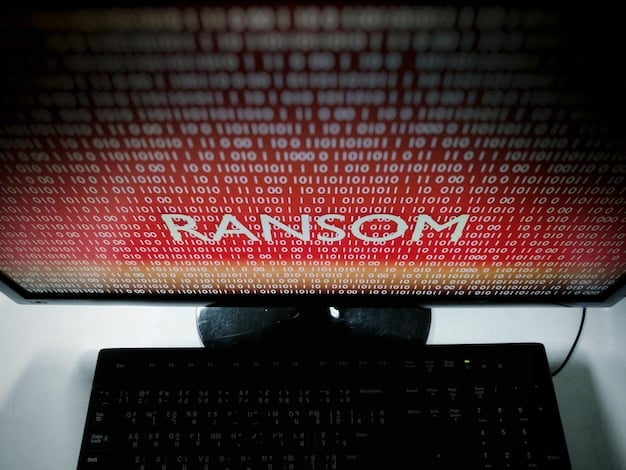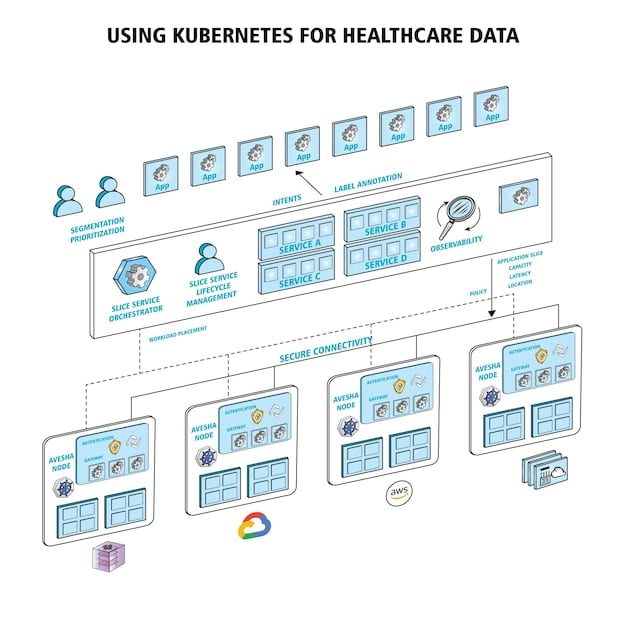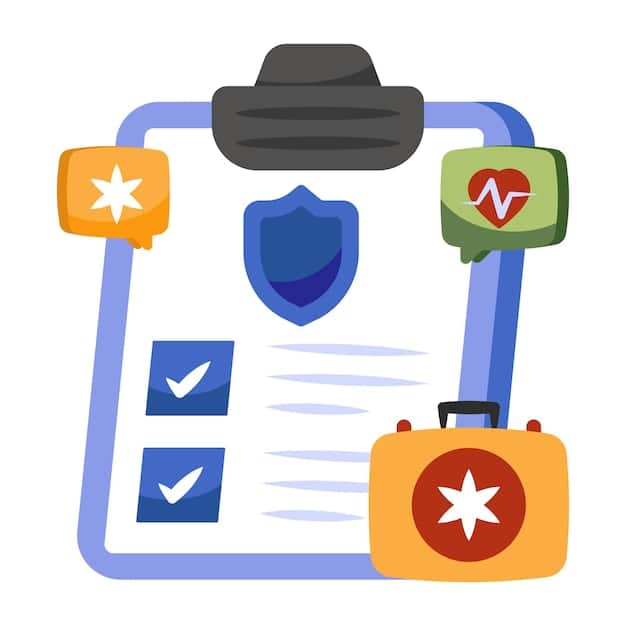Cybersecurity Alert: US Healthcare Systems Targeted by New Ransomware

A new ransomware campaign is actively targeting US healthcare systems, posing a significant threat to patient data and operational integrity, demanding immediate attention and proactive cybersecurity measures.
A Cybersecurity Alert: New Ransomware Targeting US Healthcare Systems – What You Need to Know Now is no longer a hypothetical scenario but a clear and present danger. US healthcare providers are facing an escalating threat from sophisticated ransomware attacks, jeopardizing patient care and data security. Understanding the nature of these threats and implementing immediate protective measures is crucial.
Urgent Threat: Ransomware on the Rise in US Healthcare
The healthcare sector in the United States is experiencing a surge in ransomware attacks, making it a prime target for cybercriminals. These attacks exploit vulnerabilities in healthcare systems, disrupting operations and potentially endangering patient lives. Knowing the scope and nature of this threat is the first step in building a robust defense.
The rise in ransomware incidents targeting the US healthcare industry shows a worrying development. Cybercriminals are increasingly focusing on this sector due to the sensitive nature of the data it holds and the critical services it provides. This situation requires immediate and effective cybersecurity measures.
Why Healthcare? Understanding the Target
Healthcare organizations are attractive targets for several reasons. They manage vast amounts of sensitive patient data, including medical records, insurance information, and personal details. The reliance on interconnected systems and the urgency of patient care create vulnerabilities that attackers can exploit.
- Financial Gain: Data from healthcare providers is valuable on the black market, leading to financial motivation for attackers.
- Critical Services: Disrupting healthcare services can have immediate and severe consequences, increasing the likelihood of ransom payment.
- Vulnerable Systems: Many healthcare organizations operate with outdated or poorly secured IT infrastructure, making them easy targets.

In conclusion, the US healthcare sector is targeted due to its valuable data, critical services, and often vulnerable systems. Recognizing these factors is crucial for understanding the severity of the Cybersecurity Alert: New Ransomware Targeting US Healthcare Systems – What You Need to Know Now and for implementing effective security measures.
Identifying the New Ransomware Variants
New ransomware variants are constantly emerging, each with unique characteristics and methods of attack. Staying informed about these variants is essential for healthcare IT teams to develop effective detection and prevention strategies. Understanding the specific threats allows for better resource allocation and targeted defenses.
Identifying specific ransomware variants is crucial for healthcare organizations to protect themselves effectively. Each variant may exploit different vulnerabilities and employ unique tactics. By staying informed, IT teams can better prepare for and mitigate potential attacks.
Common Ransomware Tactics
Ransomware attackers typically use a combination of tactics to infiltrate healthcare networks, encrypt data, and demand ransom. These tactics include phishing emails, exploiting software vulnerabilities, and gaining unauthorized access through weak passwords or compromised credentials.
Understanding these tactics helps healthcare organizations implement targeted security measures to protect against ransomware. By addressing common vulnerabilities and educating staff about potential threats, they can significantly reduce their risk.
- Phishing Emails: Tricking employees into clicking malicious links or opening infected attachments.
- Exploiting Vulnerabilities: Taking advantage of known weaknesses in software and operating systems.
- Compromised Credentials: Gaining access through stolen or weak usernames and passwords.
In short, new ransomware variants constantly evolve, requiring continuous monitoring and adaptation. Understanding their tactics enables US healthcare systems to implement targeted defenses and reduce their risk of becoming victims of cyberattacks, as highlighted in the Cybersecurity Alert: New Ransomware Targeting US Healthcare Systems – What You Need to Know Now.
Immediate Steps for Protection
Given the escalating ransomware threat, US healthcare providers must take immediate steps to protect their systems and data. Proactive measures, such as implementing strong security protocols, regularly backing up data, and training employees, are essential to mitigating risk. These actions can significantly reduce the impact of a potential attack.
Taking immediate steps for protection is crucial for US healthcare providers facing the growing threat of ransomware. These measures help to safeguard systems and data, minimizing potential damage and ensuring continuity of care.

Essential Security Measures
Implementing robust security measures is the cornerstone of ransomware protection. These measures include regularly updating software, using strong passwords, enabling multi-factor authentication, and segmenting networks to limit the spread of an attack.
- Regular Backups: Ensure frequent and secure backups of critical data.
- Employee Training: Educate employees about phishing and other social engineering tactics.
- Software Updates: Keep all software and operating systems up to date with the latest security patches.
- Incident Response Plan: Develop and regularly test a comprehensive incident response plan.
In conclusion, immediate steps for protection are vital in the face of increasing ransomware threats. By implementing essential security measures and fostering a culture of cybersecurity awareness, US healthcare providers can significantly reduce their vulnerability and protect their critical services.
Developing a Robust Incident Response Plan
A well-defined incident response plan is critical for healthcare organizations to effectively manage a ransomware attack. This plan should outline the steps to take in the event of an attack, including identifying the source, isolating affected systems, and restoring data from backups. A proactive plan minimizes downtime and data loss.
Developing a robust incident response plan is essential for US healthcare providers. This plan ensures that organizations can effectively manage and mitigate the impact of a ransomware attack, minimizing disruption and data loss.
Key Components of an Incident Response Plan
An effective incident response plan should include clear roles and responsibilities, communication protocols, and detailed procedures for each stage of the incident response process. This ensures a coordinated and efficient response to minimize the impact of the attack.
- Identification: Quickly identify the source and scope of the ransomware attack.
- Containment: Isolate affected systems to prevent the spread of the ransomware.
- Eradication: Remove the ransomware from infected systems.
- Recovery: Restore data from backups and verify system integrity.
To summarize, developing a robust incident response plan is vital for US healthcare organizations facing the threat of ransomware. By outlining clear procedures and responsibilities, these plans enable a coordinated response that minimizes damage and ensures business continuity. A key takeaway from the Cybersecurity Alert: New Ransomware Targeting US Healthcare Systems – What You Need to Know Now.
The Role of Cybersecurity Insurance
Cybersecurity insurance can provide financial protection and expert assistance in the event of a ransomware attack. These policies typically cover the costs of data recovery, legal fees, and ransom payments. Evaluating the benefits and limitations of cybersecurity insurance is an important part of risk management.
The role of cybersecurity insurance is increasingly important for US healthcare providers. These policies can provide financial and technical support to help organizations recover from a ransomware attack and mitigate its impact.
Benefits and Limitations
Cybersecurity insurance offers several benefits, including financial coverage for incident response, legal support, and ransom payments. However, these policies also have limitations, such as exclusions for certain types of attacks or coverage caps. Understanding these aspects is essential for making informed decisions.
- Financial Protection: Coverage for recovery costs and ransom payments.
- Expert Assistance: Access to cybersecurity experts and legal counsel.
- Policy Limitations: Exclusions and coverage caps may limit the scope of protection.
In summary, cybersecurity insurance plays a critical role in protecting US healthcare providers from the financial and operational impacts of ransomware attacks. By understanding the benefits and limitations of these policies, organizations can make informed decisions about risk management and mitigation.
Future Trends in Ransomware Attacks
Ransomware attacks are becoming increasingly sophisticated, with attackers employing new techniques to evade detection and maximize impact. Staying ahead of these trends requires continuous monitoring, research, and adaptation. Vigilance and proactive strategies are essential for long-term protection.
Future trends in ransomware attacks indicate an ongoing evolution in tactics and targets. US healthcare providers must stay informed and adapt their defenses to effectively protect against these emerging threats. Continuous vigilance and proactive strategies are essential for long-term protection.
Evolving Tactics and Targets
Ransomware attackers are constantly evolving their tactics, using advanced techniques such as double extortion, where they not only encrypt data but also steal and threaten to release it publicly. Additionally, they are increasingly targeting critical infrastructure and supply chains to maximize disruption and financial gain.
- Double Extortion: Stealing and threatening to release sensitive data.
- Targeting Critical Infrastructure: Attacking healthcare facilities and other essential services.
- Supply Chain Attacks: Compromising third-party vendors to gain access to healthcare networks.
| Key Point | Brief Description |
|---|---|
| 🚨 Rising Threats | Ransomware attacks on US healthcare systems are increasing. |
| 🛡️ Protection Steps | Implement security measures, back up data, and train employees. |
| ⚠️ Incident Plan | Develop and test an incident response plan for quick action. |
| 🔒 Insurance | Consider cybersecurity insurance for financial protection. |
FAQ Section
▼
Ransomware is a type of malicious software that encrypts data, making it inaccessible until a ransom is paid. In healthcare, it can disrupt operations, compromise patient data, and endanger patient safety.
▼
Healthcare organizations should implement strong security measures, regularly back up data, train employees to recognize phishing attempts, and develop an incident response plan to mitigate the impact of attacks.
▼
Employee training can help employees recognize and avoid phishing emails and other social engineering tactics that are commonly used to spread ransomware. This reduces the risk of initial infection.
▼
An incident response plan should include procedures for identifying the source of the attack, isolating affected systems, eradicating the ransomware, and restoring data from backups. It should also define roles and responsibilities.
▼
Yes, cybersecurity insurance can provide financial protection and expert assistance in the event of a ransomware attack. It can cover costs associated with data recovery, legal fees, and ransom payments.
Conclusion
In conclusion, the Cybersecurity Alert: New Ransomware Targeting US Healthcare Systems – What You Need to Know Now demands immediate and sustained attention. By understanding the evolving threats, implementing robust security measures, and developing comprehensive incident response plans, US healthcare providers can protect their systems, data, and ultimately, patient care. Proactive vigilance and continuous adaptation are essential for safeguarding against the ever-present danger of ransomware attacks.





